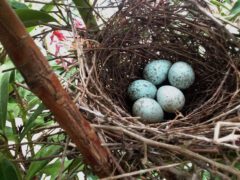Black-capped Gnatcatcher Photo Gallery
Breeding male
A small gray songbird with a long tail and long bill. Upperparts are blue-gray and underparts are grayish-white. Adult male in breeding plumage has a black cap that extends from the bill to behind the eye.
© Chris McCreedy - no playbacks / Macaulay LibraryArizona, March 31, 2018Female/nonbreeding male
Female and nonbreeding male lack a black cap. Note the white outer tail feathers contrasting with the black inner feathers.
© Chris McCreedy - no playbacks / Macaulay LibraryArizona, December 19, 2017Breeding male
A small, fidgety songbird that frequently flicks and cocks its long tail. Grayish-white below with darker gray upperparts. Adult male in breeding plumage has a black cap that stretches from the base of the bill to behind the eye. Gives a variety of nasal mewing calls.
© Joe Aliperti / Macaulay LibraryArizona, April 26, 2023Not all videos have soundFemale/nonbreeding male
Female and nonbreeding male have a full white eyering. Note the long, dark bill.
© Luke Seitz / Macaulay LibraryArizona, December 11, 2017Breeding male
The underside of the tail appears white when the tail is closed.
© Bryan Calk / Macaulay LibraryArizona, May 18, 2017Female/nonbreeding male
Nearly endemic to northwestern Mexico, but also occurs annually in southeastern Arizona in small numbers.
© Chris McCreedy - no playbacks / Macaulay LibraryArizona, December 21, 2018Female/nonbreeding male
Frequently cocks its tail like other gnatcatchers.
© Laurens Halsey / Macaulay LibraryArizona, February 23, 2016Tail is strongly graduated, with central feathers longer than outermost feathers. The two outer tail feathers are mostly white.
© Bob Friedrichs / Macaulay LibraryArizona, January 11, 2017Breeding male
Occurs in thorn scrub, dry forest, and in the northern part of its range, in woodland along creeks and rivers.
© Ryan Terrill / Macaulay LibrarySonora, April 21, 2018Compare with Similar Species
Click on an image to compare
Species in This Family
Gnatcatchers(Order: Passeriformes, Family: Polioptilidae)
More to Read
Don't miss a thing! Join our email list
The Cornell Lab will send you updates about birds,
birding, and opportunities to help bird conservation.











